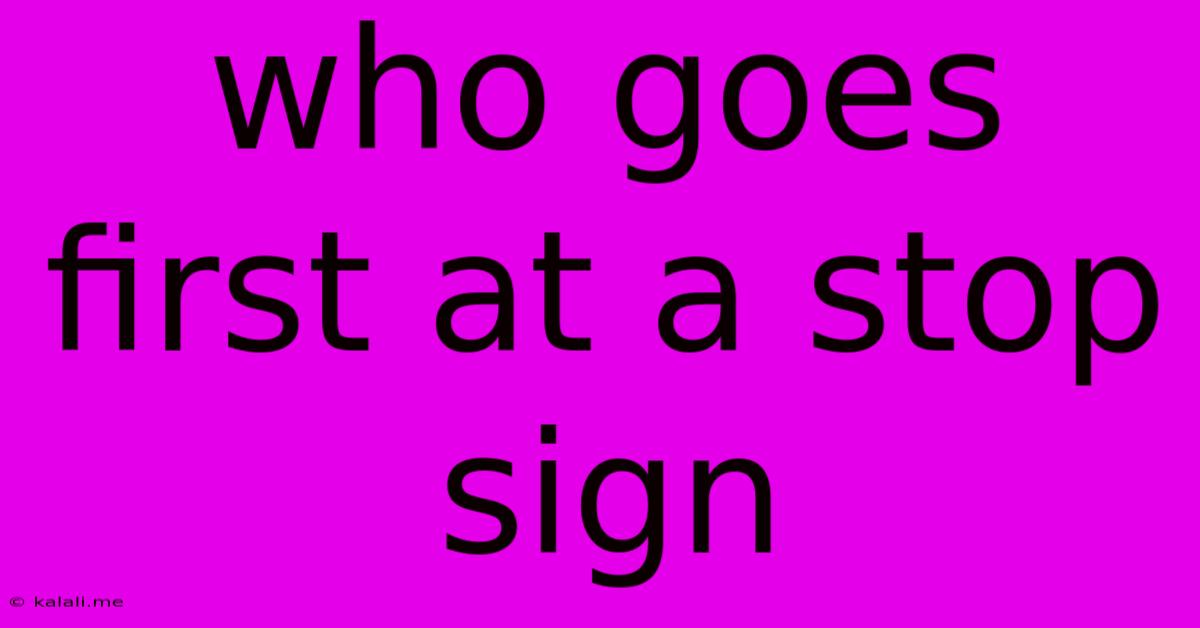Who Goes First At A Stop Sign
Kalali
Jun 08, 2025 · 3 min read

Table of Contents
Who Goes First at a Stop Sign? A Comprehensive Guide to Right-of-Way Rules
Knowing who has the right-of-way at a stop sign is crucial for safe driving. Failing to yield properly can lead to accidents, tickets, and even more serious consequences. This guide provides a clear explanation of the rules, common scenarios, and tips to ensure you're always navigating stop signs safely and legally. Understanding these rules will help you avoid conflicts and contribute to a safer driving environment for everyone.
The Basic Rule: First Come, First Served
The fundamental principle governing stop sign right-of-way is first come, first served. The vehicle that arrives at the stop sign first has the right-of-way. This means that once you've fully stopped and checked for cross-traffic, you may proceed. Simple enough, right? However, there are nuances to consider.
What Does "Fully Stopped" Mean?
"Fully stopped" implies more than just a slight deceleration. Your vehicle must come to a complete stop with the wheels stationary before proceeding. Simply slowing down and then proceeding is considered a rolling stop and is a traffic violation in most jurisdictions. Failure to come to a complete stop can result in fines and points on your driving record.
Multiple Vehicles Arriving Simultaneously: The Right-of-Way Hierarchy
Things get a little trickier when multiple vehicles arrive at a stop sign simultaneously. In this situation, a few additional rules apply:
-
Yield to the Right: If two vehicles reach a stop sign at the same time, the driver on the right generally has the right-of-way. This is a common-sense rule designed to prevent conflicting movements.
-
Simultaneous Arrival from Different Directions: If cars arrive at the intersection simultaneously from different directions, the situation needs careful assessment. Consider the flow of traffic and yield to avoid potential collisions. If unsure, it's always best to yield to avoid a conflict.
-
Observe Traffic Flow: The flow of traffic plays a vital role. Even if technically you have the right-of-way, it's imperative to use your judgement. If merging into busy traffic could be dangerous, yield to allow the other vehicle to proceed.
Special Circumstances and Considerations
Several situations require additional consideration:
-
Pedestrians and Cyclists: Pedestrians and cyclists always have the right-of-way. Before proceeding through the intersection, always check for pedestrians and cyclists and yield to them.
-
Emergency Vehicles: If you see emergency vehicles approaching, yield immediately and pull over to the side of the road. Their safety is paramount.
-
Hidden Intersections: Be extra cautious at intersections with limited visibility. Proceed slowly and carefully, ensuring that no vehicles are approaching from hidden directions.
-
Four-Way Stop vs. Two-Way Stop: The same rules apply to both, emphasizing the "first come, first served" and "right-of-way to the right" principles.
Tips for Safe Navigation of Stop Signs
-
Always Come to a Complete Stop: This is non-negotiable. Avoid rolling stops at all costs.
-
Check All Directions Thoroughly: Don't just glance – take a moment to fully assess the situation before proceeding.
-
Be Patient and Courteous: Allow others to proceed if there's any doubt about the right-of-way. A little patience can prevent a lot of trouble.
-
Use Your Signals: Signaling your intentions helps other drivers anticipate your movements.
Understanding these rules and practicing safe driving habits will contribute to a safer driving environment for everyone. Remember, being cautious and yielding when necessary is always the best course of action. If in doubt, yield!
Latest Posts
Latest Posts
-
Did The Witch Of Endor Really Summon Samuel
Jun 08, 2025
-
How To Get Spray Foam Off Your Hands
Jun 08, 2025
-
How To Increase Happiness Fallout 4
Jun 08, 2025
-
Bcftools Merge With Ref Allele Order
Jun 08, 2025
-
Difference Between Dot 3 And Dot 4 Brake Fluid
Jun 08, 2025
Related Post
Thank you for visiting our website which covers about Who Goes First At A Stop Sign . We hope the information provided has been useful to you. Feel free to contact us if you have any questions or need further assistance. See you next time and don't miss to bookmark.